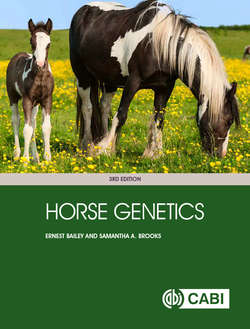Читать книгу Horse Genetics - Ernest Bailey - Страница 40
На сайте Литреса книга снята с продажи.
References
ОглавлениеBenirschke, K. and Ryder, O.A. (1985) Genetic aspects of equids with particular reference to their hybrids. Equine Veterinary Journal (Supplement 3): 1–10.
Bowling, A.T. and Millon, L. (1988) Centric fission in the karyotype of a mother–daughter pair of donkeys (Equus asinus). Cytogenetics and Cell Genetics 47: 152–154.
Bowling, A.T., Breen, M., Chowdhary, B.P. et al. (1997) International system for cytogenetic nomenclature of the domestic horse: report of the Third International Committee for the Standardization of the domestic horse karyotype, Davis, CA, USA, 1996. Chromosome Research 5: 433–443.
Boyd, L. and King, S.R.B. (2011) Equus ferus. In: IUCN (2012) IUCN Red List of Threatened Species. Version 2012.2. Available at: www.iucnredlist.org (accessed January 22, 2013).
Di Meo, G.P., Perucatti, A., Peretti, V. et al. (2009) The 450-band resolution G- and R-banded standard karyotype of the donkey (Equus asinus, 2n = 62). Cytogenetic and Genome Research 125: 266–271.
Ewart, J.C. (1899) The Penycuik Experiments. Adam and Charles Black, London. Digitized version available at: http://archive.org/details/penycuikexperim00ewargoog (accessed January 22, 2013).
Gaunitz, C. et al. (2018) Ancient genomes revisit the ancestry of domestic and Przewalski’s horses. Science 360: 111–114.
Groves, C.P. and Ryder, O.A. (2000) Systematics and phylogeny of the horse. In: Bowling, A.T. and Ruvinsky, A. (eds) The Genetics of the Horse. CAB International, Wallingford, UK, pp. 1–24.
Hack, M.A. and Lorenzen, E. (2008) Equus quagga. In: IUCN (2012) IUCN Red List of Threatened Species. Version 2012.2. Available at: www.iucnredlist.org (accessed January 22, 2013).
Houck, M.L., Kumamoto, A.T., Cabrera, R.M. and Benirschke, K. (1998) Chromosomal rearrangements in a Somali wild ass pedigree, Equus africanus somaliensis (Perisodactyla, Equidae). Cytogenetics and Cell Genetics 80: 117–122.
Kimura, B. et al. (2011) Ancient DNA from Nubian and Somali wild ass provides insights into donkey ancestry and domestication. Proceedings of the Royal Society B 278(1702): 50–57.
Lau, A.N., Peng, L., Goto, H., Chemnick, L., Ryder, O.A. and Makova, K.D. (2009) Horse domestication and conservation genetics of Przewalski’s horse inferred from sex chromosomal and autosomal sequences. Molecular Biology and Evolution 26, 199–208.
Lindgren, G., Backström, N., Swinburne, J. et al. (2004) Limited number of patrilines in horse domestication. Nature Genetics 36: 335–336.
Moehlman, P.D., Rubenstein, D.I. and Kebede, F. (2008a) Equus grevyi. In: IUCN (2012) IUCN Red List of Threatened Species. Version 2012.2. Available at: www.iucnredlist.org (accessed January 22, 2013).
Moehlman, P.D., Shah, N. and Feh, C. (2008b) Equus hemionus. In: IUCN (2012) IUCN Red List of Threatened Species. Version 2012.2. Available at: www.iucnredlist.org (accessed January 22, 2013).
Moehlman, P.D., Yohannes, H., Teclai, R. and Kebede, F. (2008c) Equus africanus. In: IUCN (2012) IUCN Red List of Threatened Species. Version 2012.2. Available at: www.iucnredlist.org (accessed January 22, 2013).
Myka, J.L., Lear, T.L., Houck, M.L., Ryder, O.A. and Bailey, E. (2003) FISH analysis comparing genome organization in the domestic horse (Equus caballus) to that of the Mongolian wild horse (E. przewalskii). Cytogenetic and Genome Research 102: 222–225.
Novellie, P. (2008) Equus zebra. In: IUCN (2012) IUCN Red List of Threatened Species. Version 2012.2. Available at www.iucnredlist.org (accessed January 22, 2013).
Oakenfull, E.A. and Ryder, O.A. (1998) Mitochondrial control region and 12S rRNA variation in Przewalski’s horse (Equus przewalskii). Animal Genetics 29: 456–459.
Oakenfull, E.A., Lim, H.N. and Ryder, O.A. (2000) A survey of equid mitochondrial DNA: implications for the evolution, genetic diversity and conservation of Equus. Conservation Genetics 1: 341–355.
Raudsepp, T. and Chowdhary, B.P. (2001) Correspondence of human chromosomes 9, 12, 15, 16, 19 and 20 with donkey chromosomes refines homology between horse and donkey karyotypes. Chromosome Research 9: 623–629.
Raudsepp, T., Christensen, K. and Chowdhary, B.P. (2000) Cytogenetics of donkey chromosomes: nomenclature proposal based on GTG-banded chromosomes and depiction of NORs and telomeric sites. Chromosome Research 8: 659–670.
Rong, R., Chandley, A.C., Song, J., McBeath, S. et al. (1988) A fertile mule and hinny in China. Cytogenetics and Cell Genetics 47: 134–139.
Ryder, O.A. and Chemnick, L.G. (1990) Chromosomal and molecular evolution in Asiatic wild asses. Genetica 83: 67–72.
Ryder, O.A., Epel, N.C. and Benirschke, K. (1978) Chromosome banding studies of the Equidae. Cytogenetics and Cell Genetics 20: 323–350.
Ryder, O.A., Chemnick, L.G., Bowling, A.T. and Benirschke, K. (1985) Male mule foal qualifies as the offspring of a female mule and jack donkey. Journal of Heredity 76: 379–381.
Shah, N., St Louis, A., Huibin, Z., Bleisch, W., Van Gruissen, J. and Qureshi, Q. (2008) Equus kiang. In: IUCN (2012) IUCN Red List of Threatened Species. Version 2012.2. Available at: www.iucnredlist.org (accessed January 22, 2013).
Steiner, C.C. and Ryder, O.A. (2012) Molecular phylogeny and evolution of the perissodactyla Zoological Journal of the Linnean Society 163: 1289–1303.
Trifonov, V.A. et al. (2008) Multidirectional cross-species painting illuminates the history of karyotypic evolution in Perisodactyla. Chromosome Research 16: 89–107.
Wallner, B., Brem, G., Müller, M. and Achmann, R. (2003) Fixed nucleotide differences on the Y chromosome indicate clear divergence between Equus przewalskii and Equus caballus. Animal Genetics 34: 453–456.
